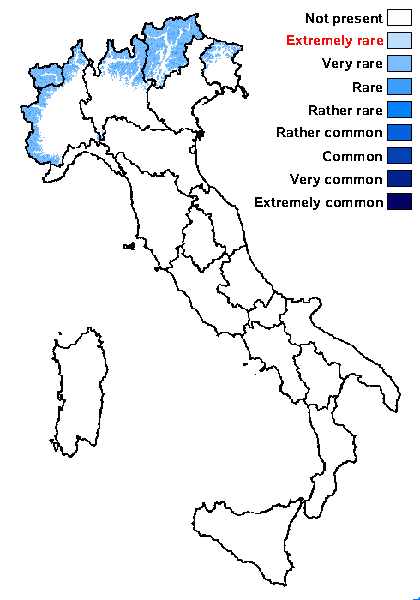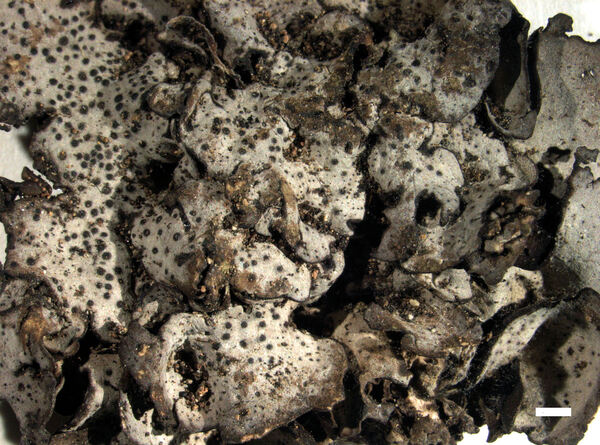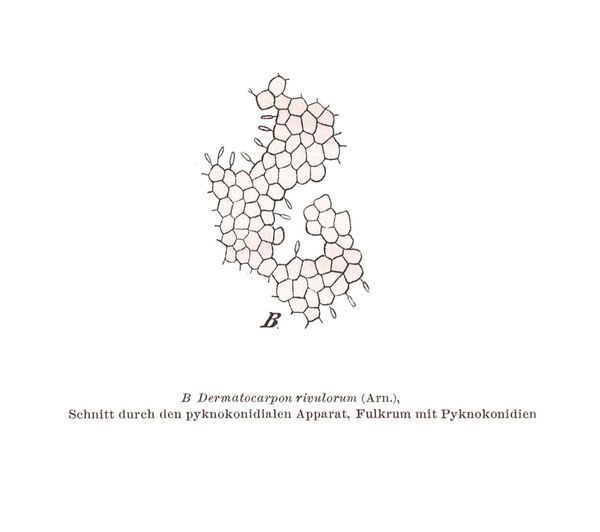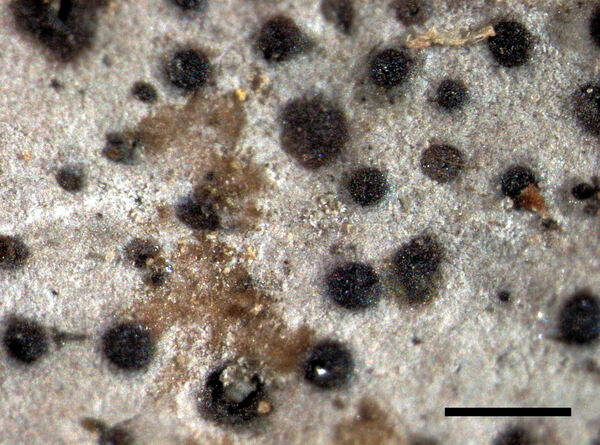Dermatocarpon rivulorum (Arnold) Dalla Torre & Sarnth.
Die Flechten von Tirol: 504, 1902. Basionym: Endocarpon rivulorum Arnold - Verh. zool.-bot. Ges. Wien, 24: 249, 1874.
Synonyms:
Distribution: N - Frl (TSB 4608), TAA (Nascimbene & al. 2007b), Lomb, Piem (Isocrono & al. 2004, Isocrono & Piervittori 2008), VA (Piervittori & Isocrono 1999, Isocrono & al. 2008).
Description: Thallus foliose-umbilicate, heteromerous, dorsiventral, monophyllous, rather large, (10-)13-30(-45) mm wide, attached by a central holdfast, rather thin, 0.1-0.35(-0.5) mm thick when wet. Upper surface brown to dark brown, epruinose, bulging; lower surface more or less concolorous with upper surface, distinctly reticulate, erhizinate. Upper cortex pseudoparenchymatous, of anticlinally arranged hyphae, often with a brown pigment near the surface, overlain by an epinecral layer of compressed hyphae; medulla white, I-; lower cortex colourless except the brown outermost part. Perithecia numerous, immersed in the thallus and scattered over almost the whole upper surface (appearing as black dots), the ostiole immersed or slightly projecting, without involucrellum. Exciple colourless except in the brown uppermost part; hamathecium of periphyses and periphysoids, interascal filaments absent; hymenial gel hemiamyloid. Asci 8-spored, clavate, I-, fissitunicate, the wall thickened above, with an ocular chamber, dehiscent by extrusion of an endotunica to form a delicate rostrum, Verrucaria-type. Ascospores simple to rarely 1(-4)-septate, (14-)16-21(-26) x (5.5-)6- 8(-10.5) µm. Pycnidia rather common, black, sometimes immersed in warts, multi-chambered. Conidia short-bacilliform. Photobiont chlorococcoid. Spot tests: cortex and medulla K-, C-, KC-, P-, UV-. Chemistry: without lichen substances.Note: a widespread, cool-temperate to arctic-alpine, circumpolar species found on periodically submerged siliceous rocks, in seepage tracks or along small streams, often completely inundated during summer; it also occurs in melt-water seepages below snow-beds and along lakeshores.
Growth form: Foliose, umbilicate
Substrata: rocks
Photobiont: green algae other than Trentepohlia
Reproductive strategy: mainly sexual
Periodically submerged (e.g. in creeks)
Commonnes-rarity: (info)
Alpine belt: very rare
Subalpine belt: rare
Oromediterranean belt: absent
Montane belt: very rare
Submediterranean belt: absent
Padanian area: absent
Humid submediterranean belt: absent
Humid mediterranean belt: absent
Dry mediterranean belt: absent

Predictive model
Herbarium samples
Growth form: Foliose, umbilicate
Substrata: rocks
Photobiont: green algae other than Trentepohlia
Reproductive strategy: mainly sexual
Periodically submerged (e.g. in creeks)
Commonnes-rarity: (info)
Alpine belt: very rare
Subalpine belt: rare
Oromediterranean belt: absent
Montane belt: very rare
Submediterranean belt: absent
Padanian area: absent
Humid submediterranean belt: absent
Humid mediterranean belt: absent
Dry mediterranean belt: absent

Predictive model
| Herbarium samples |
 INDEX FUNGORUM
INDEX FUNGORUM
 GBIF
GBIF
 DOLICHENS
DOLICHENS





